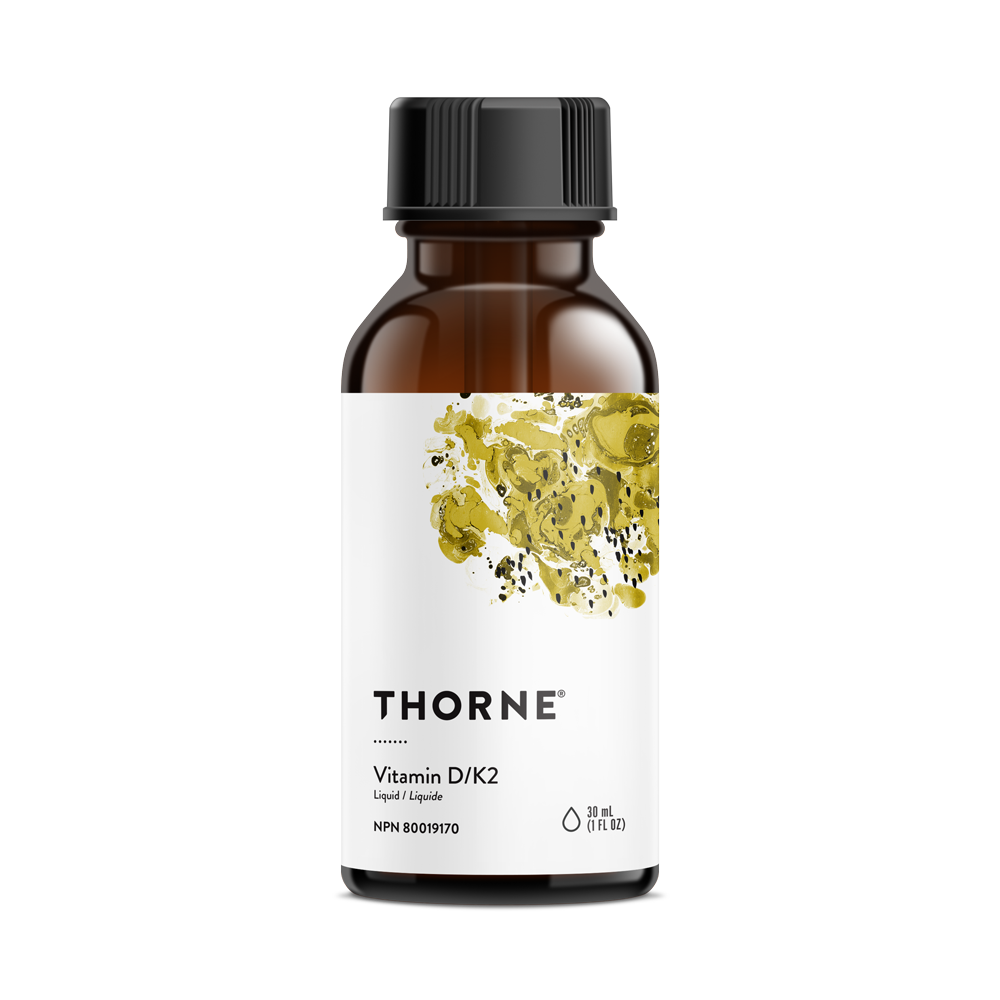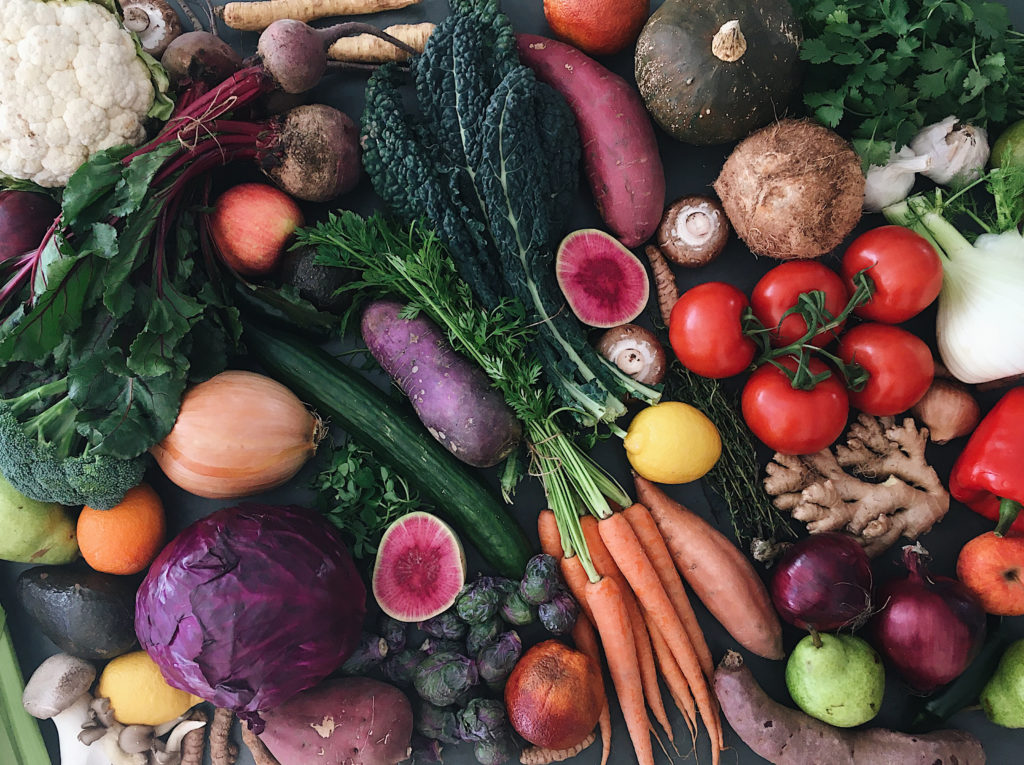
The most erroneous stories are those we think we know best—and therefore never scrutinize or question.
Stephen Jay Gould
Today I am here to proclaim that long-term veganism no longer serves me on my life path after about half a decade of a whole foods, low-tox and mostly organic plant-based lifestyle, and that while it does have its place, I can no longer wholeheartedly advocate for sticking to it (or any ideology) when it comes to a thriving, resilient body. Yes, I eat local, ethically pasture raised, grass–fed beef liver pâté now, practicing a kind of conscious omnivory. What follows is not meant to come across as elitist or preachy by any means, but I hope it provides you with a little insight into my unique path, and possibly help you along your journey towards reclaiming your health and resilience, if this resonates with you. My views are my own, as usual.
First, allow me to address the reality that no single lifestyle ideology or dietary pattern “fits” every being. There are studies everywhere that support every diet ideology under the sun whether it’s vegan, keto, carnivore, paleo or AIP… and that’s great! They all serve their purpose and can guide you along your understanding of nutrition to a degree, and everyone’s got different and evolving needs and goals: in fact, I invite you to get creative with the recipes on this blog to fit your needs. I believe that much of the time, these dietary and lifestyle guidelines should proactively be used as fluid, flexible tools rather than immutable, dogmatic and rigid rules to react to or live by, all without having them take over your life.
We are not robots. We are highly bioindividual, with our resilience dependent on so many changing factors from sun exposure to ancestry to metabolic processes, to food and supplements, to our environment, emotional conflicts, social circles, and whatever we slather on our skin, and even down to our thoughts. Maybe it’s just me, but I think that staunchly living by a diet ideology can be incredibly stultifying and even simply boring after a while. At the end of the day, only you truly know yourself and your body’s needs at any moment: live your life and thrive on whatever you feel called to. But it is only when we believe things to be permanent (like dogmatic ideology) that we shut off the possibility of learning from change, evolution, and boundless impermanence.
Modern day veganism (or plant-based) has become wildly popular as some sort of panacea in the health and wellness industries, and I get it. I’ve been there. Factory farming is a reality, and using suffering animals as part of industrial practices is unnecessarily cruel and inhumane. I have seen it all, and it’s why I started going with conventional vegetarian and lacto-ovo-pescetarian foods at the age of 14. It was exactly what I needed at the time with the tools that I had. Veganism is so often entangled into the notion of being a “good human” by living a “cruelty-free” lifestyle, and that’s a great intention. It’s easy to adopt a lifestyle as a sort of external badge or signaling in the name of ethics or morality… but it comes at the expense of our own health and many other aspects of existence (“good” or “bad”). The reality is that nothing is completely 100% cruelty-free for many reasons, and we all carry a multitude of contradictions and multidimensionality. The flowing line between good and evil resides within each of us, and the church of veganism, while well-intentioned, is blinding many from seeking greater truths and experiences when it comes to cultivating health, sovereignty, compassion and coexistence with the body, mind, earth, and spirit. It has its place, but is ultimately just another ideology from the same modern society that taught you to eat factory farmed flesh.
These days, mainstream veganism has become rife with industrialized food-like products, often in the form of meat and dairy substitutes like Beyond Meat with petroleum-based packaging, made with mono-cropped plants, created in a lab, pumped with “natural flavours” and industrially processed, glyphosate-ridden seed oils, and eventually shipped long distances to get to your table. To me, it seems silly at this point to suggest that veganism can “save the planet” as so many of its proponents preach, and I personally don’t feel drawn to these products as they simply do not serve my highest good. A lot of this stuff is easy to cling to and sadly easy to access, but I don’t feel called to consume any of it as I personally have the ability to make certain choices for my own sense of health and goals.
Don’t get me wrong—plant-based foods are delicious and can be highly beneficial and easier on the wallet as well, but the vegan label itself is no panacea. When it comes to connecting to plants’ living intelligence & spiritual consciousness through their chemicals to heal us in profound ways, or as a short-term stint according to the body’s intuition in the sense of simple, single ingredient, nutrient dense and properly prepared (soaked and/or sprouted for 24-48 hours) organic fruit, vegetable, nut, seed and properly soaked whole grain meals that are easy to digest, foods that happen to be vegan can be great! It has its place and can offer the body a nice break from the energy burden of digesting proteins and healthy fats (similar to a fast), and it’s great if you want to live ascetically like a monk for short periods of time, but so often comes at the expense of physical and mental resilience over time. Over the long term, it is another form of imbalance that has sprung from an imbalanced culture so disconnected from the synergy of the Earth’s cycles and rhythms (now more than ever, we *really* need to reconnect with our food and the land we reside on).
Whether you’re staunchly vegan or not, one of the big problems in Western/industrialized cultures is that there is a massive disconnection from death and discomfort, and conditioning from birth with a distrustful, often harmful and reductionist approach to our very own bodies, and I believe this tendency underpins much of vegan ideology and its popularity. It seems to have taken hold as an unnatural means to cling to life and deny the potentiality of reinhabiting and connecting further with the land, food and ourselves, entangled with an inability to fully face the inevitability of death (ironically, when there is a sense of lifelessness that animates much of Western lifestyles!). In what ways can we grapple with the reality of conflict and death interwoven into the impermanence of life? In what ways can we go beyond boundaries and limits? Life may be full of pain and suffering, every time you step out of the door, you’re killing something, but these are opportunities handed to us to arrive towards an emotional acceptance of death, to continuously prepare for it, to connect to our purpose and live a meaningful life.
We are earth, within us lies the harmony of her cycles, rhythms, and intelligence beyond our logical minds. All of us creatures are a part of the circle of life whether you like it or not, and we probably can’t exist without living foods — plants and animals alike — full of the same force that animates all of life on earth. We live, breathe, grow and die in a continuing dance of birth and death, and it’s possible to acknowledge commonly held anthropocentric fallacies while knowing that no living entity is no more “alive” than another, that humans (in Western/industrialized cultures) mistakenly believe that animals have more of a “right” to live than plants do, just because we share eyes, nose and a mouth. This is no Walt Disney world. In fact, according to Stephen Harrod Buhner’s Plant Intelligence and the Imaginal Realm, plants, like other animals, are highly complex organisms that are conscious with physical, energetic and spiritual qualities, they do feel pain and have similar neural networks as we do, in their roots. Some plants even possess more neurons than we do! Root systems perform similarly to the neural network in our brains, they use the same neurotransmitters we do to store memories, plan for the future, and analyse inputs and design responses. This includes feeling pain: they can experience inflammation in their cellular tissues that signals repair mechanisms in the body to respond to and heal damage, just as we do. (I’m really into a lot of Stephen’s work because it invites the average domesticated human to discover and dance in the wild, non linear spaces beyond [or with] prevalent and reductionist Western approaches and tendencies, accepting the mysteries of nature and our limitations with humility.)
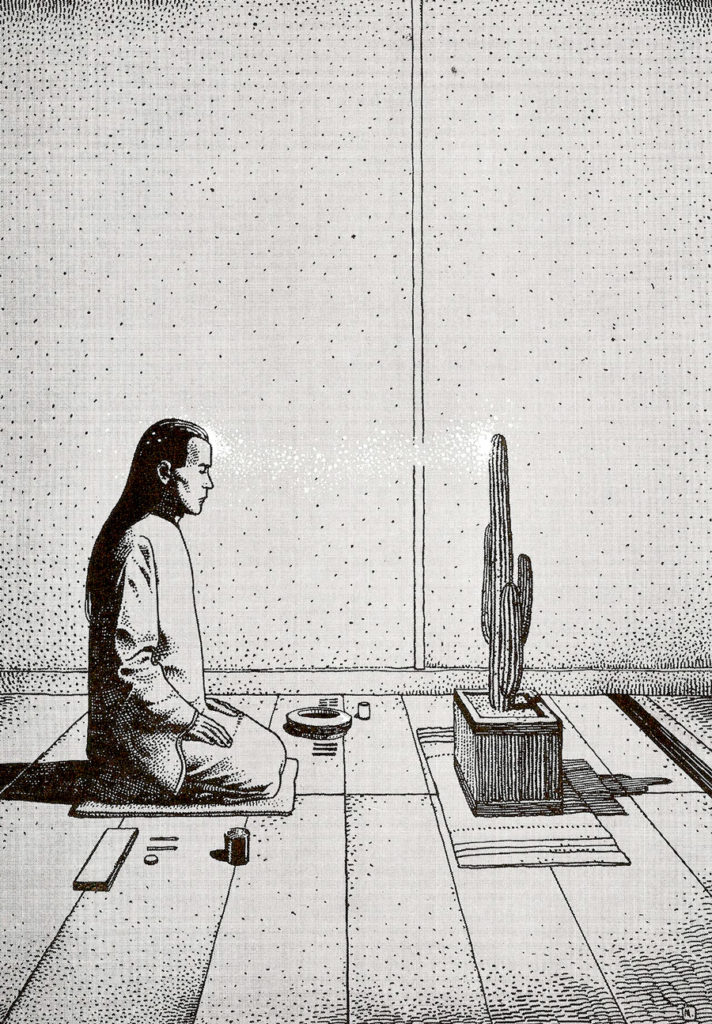
Anyways, all plants, animals and living beings carry different energy, and it’s a beautiful thing. When you consciously use the life force of local, organic plants and ethically raised (at least to a higher degree than conventionally farmed) animals to sustain your existence, you end up carrying the energy of the lives that gave theirs to sustain yours (and eventually to decay back into the earth, to continue the cycle again). It encourages us to remain humble towards them, to express gratitude towards the life that sustains us, and to be respectful. It’s up to you how you want to use this energy, will you choose to live well, with honesty, purpose, integrity and compassion?
Life is beyond black and white, there is only change and flow. The reality is that nourishing yourself with ethically raised or wild caught animals and animal-based foods is required for mental, physical and spiritual resilience… consider the work of Weston A. Price, for starters. There can still be a degree of love and compassion with minimal suffering in a transaction of death, as was done before industrial practices. There is no food without death, it takes life to sustain life. At the end of the day, do what you want, but to me, veganism is a slow death, it is unnatural, it is not “healthy” nor does it “save the planet”… especially when it comes to birthing and nourishing children, which requires the complete building blocks from whole animal based foods.
In fact, a huge reason why I advocate hunting for wild game now is that it’s an opportunity to cultivate a stronger connection to your food, the land and each other, and the animal would have lived a free life, roaming in the sunlight as they please, with a quick and minimally painful death, potentially a highly nutritious way to sustain your life (and support the life around you). Organic, ethically and holistically pasture (sun) raised healthy animals (and plants) are the next best option: raised in the sun with the highest degree of integrity as opposed to the unnecessarily cruel and inhumane practices done in slaughterhouses, and yes, that which occurs more indirectly through mass produced “meat”-like products, destructive industrial mono-cropping, and industrially produced, packaged plant milks.
It is impossible for a diet that’s healthy for people to be unhealthy for the earth. It’s impossible for a diet that’s healthy for you to be unhealthy for your liver. Health is fractal in all directions.
—Anonymous
What if the planet doesn’t need to be “saved” – and the only thing we can save is ourselves?
Going beyond veganism
When I transitioned from a conventional semi-vegetarian diet with lots of processed fake “food” (for 10-12 years) to a 99% whole foods, 100% plant-based, and 95% organic/biodynamic vegan diet (over 5-6 years), I immediately noticed boundless energy and a zest for life I probably wouldn’t have tapped into otherwise, as with any elimination diet. My skin was clear and I felt amazing, so much that I nearly felt compelled to proselytize the power of plants to anyone who would listen! It was exactly what I needed at the time with the tools and information that I had.
What should be known is that most people do indeed end up feeling “lighter” and “cleaner” only because they’ve detoxified from the conventional Standard American Diet (pesticide sprayed, factory farmed, unseasonal, mono-cropped and shipped from many miles away from the incorrect latitude, aka typical grocery store and restaurant food that won’t properly inform your metabolism and circadian health from the UV light information found in plant foods). They are still not getting the bioavailable nutrients that only ethically sourced, pasture raised, grass fed and grass finished, local animal foods provide. To me, a plant-based diet (whether locally sourced or shipped from far away) is essentially just a form of fasting and even nutrient depletion from improperly prepared, and often out of season and latitude, plant foods.
Over the long term, I learned the hard way that I was slowly depleting my body despite taking the time to research and consume every exotic expensive organic “superfood” I could find at the health food store, combining different, properly prepared plant foods to marginally increase bioavailability, and supplementing B12 through nutritional yeast along with other vitamins through blood-building natural multivitamins and fortified, packaged plant milks/”mylks”, which was very time consuming. Yes, I was energetic, but also easily irritable, moody, anxious, constricted, constantly hungry, and dare I say… more boring. That energy often felt like a sort of mania which was actually a result of the copper toxicity (which contributes to numerous diseases, notably cardiovascular, with a negative impact on immunity) and B12 deficiency induced by whole food organic plant based veganism. Long term, I developed further teeth deterioration, muscle wasting and mild neuropathy/a “nerve pinching” feeling in my arms that I’ve now resolved with the reintroduction of animal foods. My menstrual pains and PMS had never been an issue for me until after a few years of this “healthy” veganism, and in fact, as they became more excruciating over a span of 3 years, it got to the point where I would hunch over at my office desk, nearly unable to move (magnesium really would’ve helped here). I had chalked it up to “just getting older”, but my body was trying to tell me something, and I was there to listen. I decided if it kept getting worse, I would see a health practitioner about it, but I ended up not needing to.
Tuning into the intelligent power of intuition
Around that time, one night I dreamt of chicken eggs and started craving them from the depths of my being. I decided to listen to that instead of any sort of rationally driven, externally imposed rules, and it was almost a sort of pre-conscious knowing I was tapping into. I had coincidentally been reading about hormone balance and how it takes approximately 3 months for the body to rebalance them after implementing proper practices, and I genuinely believe that reintroducing local, ethically pasture raised eggs helped play a role in rebalancing them for me (was it the beneficial cholesterol?).
I have seen various health practitioners on Instagram, of all places, constantly drive home the notion that PMS symptoms (including any level of cramps) are a sign of imbalance and the fact that these symptoms are so common these days is a sure sign that the ways that we are generally living are not supporting our potential to thrive in ways we can try to discover. In the end, our bodies know best, despite what many ‘experts’ (often just trying to make a profit) have to say: we are all just guessing based off of information that resonates with us. I truly believe that it’s our own bodies and our intimate connection with them that holds the answers when it comes to ongoing healing, resilience, and even anti-fragility.
After about 3 months cooking with eggs (‘sup home cooked shakshuka nearly every day) along with organic whole foods, stress reduction, and efforts towards proper sunlight exposure and sleep hygiene, I have not experienced menstrual issues or severe PMS since then. At the time of writing, it has now been 9 months and counting. Amazing, right?
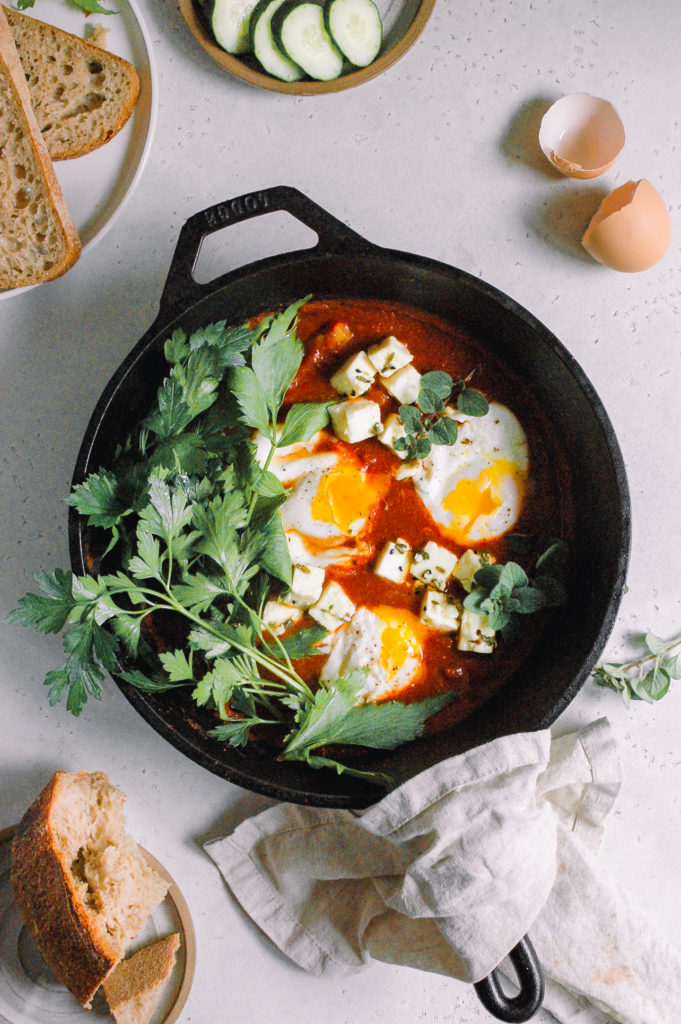
I’m not going to say that what works for me may necessarily work for you, but returning to organic eggs by local chickens ethically pasture raised in the sun was one of the best things I’ve ever done for myself, as was introducing local, nose-to-tail, grass fed and finished, pasture raised bone broth, grass fed butter, wild caught salmon and other seafood, and the odd few chunks of grass fed and finished, properly sourced, regeneratively pasture raised animal meat every now and then. My first bite of red meat along with increased sunlight exposure after 15 years felt quite new, and ultimately so right—and I did not get sick at all. I felt a warmth, groundedness and joy that I hadn’t felt in a long time. I ended up resolving long term anemia and B12 deficiency with the red meat and organ meats alone, no supplements needed. I finally felt like myself. Properly sourced, ethically sun raised animal fats and organ meats changed the game. I’d much rather be a little plump and relatively happy/at peace while enjoying healthy fats than malnourished, depleted, thin as a rail, anxious, and neurotic.
I still enjoy plant-heavy meals that can be considered vegan much of the time, but it’s no longer an inflexible, artificially imposed rule. At first, vegan life felt kind of forced, and I did not respect myself enough or have a cultivated foundation (also known as Jing, one of the three treasures in traditional Chinese medicine) to address and tap into my true needs and instincts. The ideology then became really automatic and disconnected from my nature, almost ego-identified as a part of who I “was”. I don’t regret experimenting like this—in fact, the whole experience gave me all the information I needed to get to where I am now.
Looking back, something in me was actually hesitant to “go vegan” at first. It felt quite unnatural and against my divine instinct as I really enjoyed eggs, but my desire to be a “good person”, “save the environment and animals”, and “improve my health” all at once took over. I was vulnerable, depleted and already malnourished from vegetarianism, drank the Kool-Aid, and it was almost like I was initiated into a cult or religion, finding a sense of purpose and ego-identification.
I can’t tell if I’m any more proficient in certain tasks from these brain-boosting, deeply nourishing animal foods, but I’ve found that I’m less prone to stressing out, less reactive and moody, and more equanimous, grounded, confident, focused, patient, balanced, determined, adventurous, clear, coherent, and better able to support others in general. I perform much better at work and in business. I feel I can more easily experience joy in life. Overall, a huge improvement on the mental, emotional, and grounded side of things in particular. Plus, I can actually write this article 😉
(Re)introducing properly sourced animal foods
If you’ve made it this far and find yourself with a similar curiosity, here are my top tips when it comes to wisely (re)introducing animal foods while healing your gut microbiome. Veganism over a long period of time promotes deleterious effects on the body, brain, and nervous system, from hormones to digestion, gut health, fertility and your ability to absorb protective nutrients, so do cultivate patience when building yourself back up. Note this is only my advice based on my experience, so please seek the guidance of additional, verified sources, your primary doc, and/or a naturopathic or functional/integrative healthcare practitioner that you trust if you want to dig deeper, and don’t be afraid to ask questions.
Heal. That. Gut.
No matter your dietary inclinations, healing your gut is central to everything that happens in your body, including your mood and mitochondrial health. Numerous studies in the past two decades (so recent!!) have demonstrated links between gut health and the immune system, mood, mental health, autoimmune conditions, endocrine disorders, skin conditions, and cancers. Oversanitized, sedentary, indoor Western/modern lifestyles with artificial lighting, plastic wrapped chemical cleaning and conventional personal care products, unfiltered shower water full of chlorine and polluted indoor air all have our gut microbiomes and immune systems absolutely depleted, so it’s no wonder these ailments are so common these days, especially riding off of the Industrial Revolution. Whatever your dietary preferences are or whatever your path is like, I think taking ongoing responsibility for nourishing your gut can help you thrive despite these challenges. Do what you can with what you’ve got to create balance.
One of the first things I’d recommend is to restore balance by rebuilding and repopulating the gut microbiome, and there are many ways you can do this whether you’re coming off of a nutritionally deficient vegan diet or not. Personally, I haven’t taken any specific probiotic supplements as I have not yet been called down that route. I can, however, attest to the healing and feel-good, immune-boosting powers of a vast variety of both PREbiotic and PRObiotic whole foods.
Prebiotics are basically food for the probiotics, and you can visualize them like the soil that nourishes seeds. It doesn’t matter how organic the seeds are if the soil is depleted of nutrients, so be sure to fuel up with prebiotics! Some probiotic supplements have a built-in prebiotic, but foods grown organically (not monocropped and sprayed with pesticides) in nutrient-rich soil are also a great source (and it’s what our ancestors thrived on). Some prebiotic foods include chicory, garlic, onions, asparagus, leeks, chia seed, flax seed, dandelion, and Jerusalem artichoke, ideally raw and consumed daily with probiotics as part of regular meals. You can find them at your local farmers’ market, health food store, or likely in the natural foods or produce section of your local supermarket (or better yet, grow them yourself!).
Unless you’re on a strict low histamine regimen or you have other requirements, and of course N=1, probiotic living foods on the other hand are also vital, in my humble opinion. From a vast variety of sauerkrauts to yogurt, kimchi, kvass, kefir, traditional miso, traditional kombucha (not the glorified soda pop commonly on shelves), and even fermented fruit: these foods have become wildly popular in the past decade as they’re incredibly powerful, and a single spoonful is often more diverse, complex and potent than the contents of a whole bottle of probiotic pills (quoted from Sally Fallon Morell, author of Nourishing Traditions). Generally the recommended serving is about a tablespoon or a condiment’s worth daily. I highly recommend choosing freshly made ferments with organic or biodynamic ingredients, without preservatives, municipal or unfiltered tap water, or processed iodized salts (although other food sources of iodine are vital), and these are often found in the cold section of your supermarket or farmers’ market. Read the label (ideally you’ll want to get to a place where no label is needed to be read at all)! Most of all, I recommend taking the 15-20 minutes to make your very own as it’s more satisfying, you can control exactly what goes into it, how strong it’ll be, and it’ll be fresh and alive.
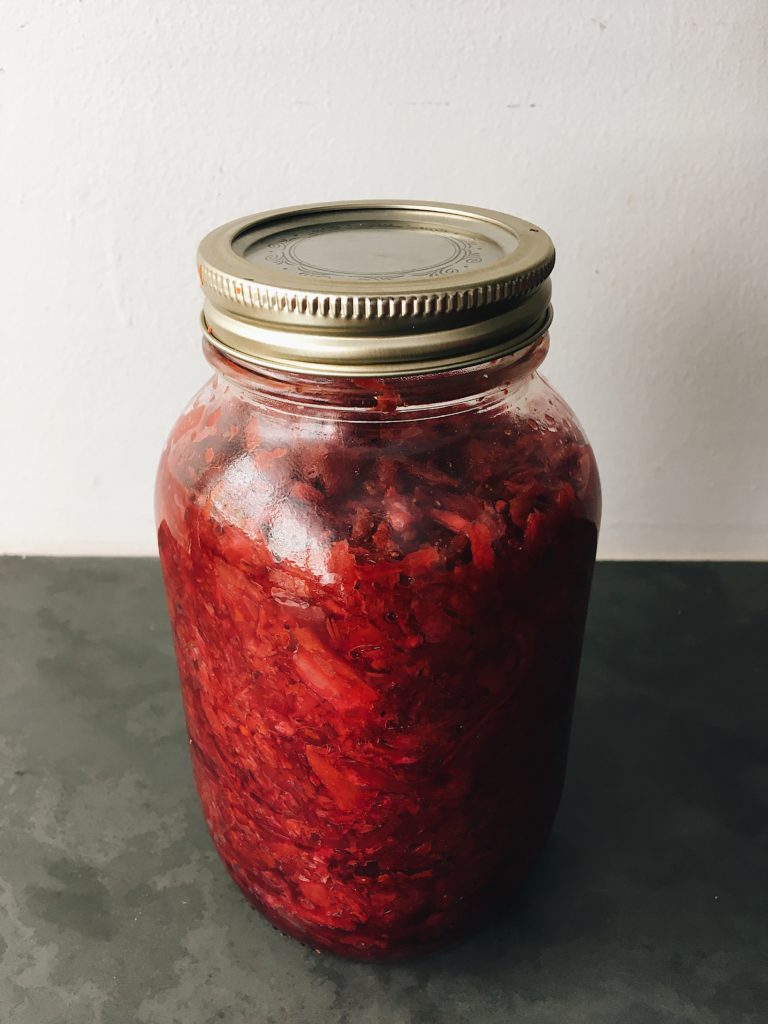
Rebuilding the gut microbiome is key to restoring digestive strength and gut health to properly digest and absorb nutrients, and the first thing I knew I had to implement aside from eggs was grass-fed, pasture raised bone broth to support this. Personally, I cannot recommend it enough, and I find that homemade bone broth, sunlight exposure, beetroot kvass and sauerkraut are all I need at the moment to help maintain my gut balance. My skin was already clear from a whole foods vegan diet, but now it has an innate glow, elasticity and smoothness from the collagen and other powerful nutrients. More importantly, I’ve also noticed subtle shifts in my mental well-being and sense of sturdiness, groundedness and resilience (quite a notable shift for me, as my constitution has traditionally been frail and predominantly “vata” in the Ayurvedic sense). It can be fun and interesting to notice different shifts with your body as you try new modalities.
Click here to learn how to make your own bone broth – chaga version!
Making a concerted effort to include nutrient dense foods as the foundation of your diet is one of the best things you can do for your health, and supplements ideally won’t even be necessary. Diet and gut health are inextricably linked; you are literally what you eat. If you can: try your best to totally ditch sugar and processed foods including ones made with industrial seed oils (including corn, peanut, vegetable, and canola, and even if a bottle of canola oil is labelled ‘organic’ that doesn’t mean it’ll nourish you, and can still promote inflammation in the body like other vegetable oils).
Opt for high fiber, organic/biodynamically grown foods (such as legumes, beans, peas, oats, bananas, berries, asparagus, and leeks that have shown a positive impact on gut health in numerous studies), garlic and onion, fermented foods, and collagen boosting (aka gut healing) foods such as pasture raised, grass fed bone broth, mushrooms, and wild caught salmon. As you get closer to sun-ripened foods that work for you while creating things with your own hands, your body, mind and spirit will probably thank you. You just have to be willing to take care of yourself.
Healthy, fat soluble vitamins A, D, E and K from whole foods are also not possible to attain on a vegan diet and you’ll undoubtedly be lacking in them especially over a long period of time. Most people in modern post-industrial times (yep, I called it) are lacking in these vital nutrients. Like feeds like. These are abundant vitamins that animals store in their fat, synthesized over time through their natural, grass fed and grass finished diets and pasture raised, free roaming lifestyles with proper sun exposure facilitating vitamin D synthesis. Get intuitive, stay open to adventure, and get to know what works for you. I almost wish I didn’t have to say this as sourcing high quality meat can be more expensive, but high quality nose-to-tail foods heal on all levels, from addiction to autoimmunity, or complicated and even more expensive health situations down the line. Even if you cannot afford or access the highest quality animal foods, start with what you do have access to and work your way up.
On a vegan diet, you also miss out on B12, bioavailable DHA, Vitamin D3, choline, taurine, creatine, tyrosine, collagen, vitamin A, haem iron, and carnosine. You risk serious neurological compromise due to B12 deficiency, not only for yourself, but for your children if you intend on giving birth (both vegan and vegetarian). Not to mention the interference of anti-nutrients in plant foods that destroy and inhibit the proper absorption and utilisation of many essential nutrients.
Note: factory farmed, low quality, commercial meat, as you might guess, is a no go here. I’m sure you’d have no problem forgoing these if you’ve been plant-based, vegan or vegetarian. Yes, it may look the exact same as pasture raised meats, but it is not the same.
Ethically raised animal foods: quality over quantity
- Organic, wild caught, pasture raised, grass fed AND grass finished, and local are good guidelines to follow. Yes, it can be more expensive, but you’ll need less of it. If you still find yourself a bit turned off of eating animal flesh (as I was at a certain point), smaller portions are totally fine even just a few times a month (depending on what you’re comfortable with), so it’s even better. Grass fed collagen powder and bone broth may be good places to start if you’re squeamish about meat.
- Grass fed beef liver: This stuff is so, so nutrient dense that I feel like I could just integrate this into my meals once or twice a month and still thrive on plant-based meals for the rest of the time, if it really came down to it. Making a delicious liver pâté to spread on organic sourdough or whey fed bacon slices, sautéd in whey fed lard, or sneaking it into a bolognese sauce are great ways to consume it. Not all liver is the same, so source wisely. By the way, toxins are not stored in the liver but you’d want to consider the environment the animal was brought up in, regardless. Liver of lamb, bison, turkey, chicken, duck, rabbit, venison, etc. are also great!
- Wild whole cod liver (better than cod liver oil, which is often rancid and does not contain the entire spectrum of nutrients)
- Wild caught fish (never farmed, even if organically)
- Pasture raised, local eggs: corn and soy free (I’m very lucky to live 20 minutes away from a permaculture farmer who has free roaming chickens and ducks on grass under the sun, but your local farmers’ market or health store is sure to have some)
- Grass fed raw organic butter/ghee (if you can tolerate dairy—I opt for goat’s over cow’s)
- Grass fed raw organic goat or cow kefir (pasteurized is also fine if raw cannot be found)
- Grass fed collagen powder can be great to pop into cooking and baking, smoothies, and soups
- One reason that eating nose-to-tail is preferable is that glycine from adequate amounts of organ meats and gelatinous bone broths offsets and balances out carcinogenic methionine from solely eating muscle meats. The nutrients (aka detoxification potential) you’d be getting from nose-to-tail eating would be more protective metabolically and on every level than from a vegan/plant-based diet when looking at the bigger picture. Copper in liver also balances out zinc in muscle meat.
- Nose-to-tail animal foods work best in tandem with the huge piece of the puzzle: sunlight exposure to tolerance on bare skin and magnesium supplementation (more on this in the next few sections). When people talk about “ancestral foods”, I like to look back to our connection with the sun and sea.
It is commonly held that for a vegan diet, walnuts, chia, hemp and flax seeds provide a source of adequate Omega 3 for the body, and they are delicious—I use them often, but they are in fact the ALA branch of Omega 3, which is a precursor to EPA/DHA that the body needs with only a conversion rate of about 1% or up to less than 10%, which I wouldn’t recommend as your sole source. In my experience, it is much easier to get well-rounded vitamins from ethically raised/wild caught animal sources: smaller, wild caught fatty fish like anchovies, tuna, trout, herring, sardines, mackerel and wild salmon, wild shellfish/bivalves like oysters, clams and mussels, fish eggs/caviar, cod liver, or found in small amounts in pasture raised, grass fed + finished meat and/or raw dairy. Avoid farmed fish, tuna, shark, and swordfish as these are all larger creatures that accumulate more toxins.
A whole food vegan diet might have been more feasible before the invention of artificial lighting while living closer to the equator, but in today’s environment, it will not help you withstand the many environmental stressors including artificial light especially past sunset, and isolated blue light from indoor screens that damage the body on profound levels and cause leaky gut. Wild seafood, shellfish/crustaceans, and bivalves in particular are all brain-boosting, hormone and blood sugar balancing, and artificial blue light protective via the high conversion rate of DHA/EPA otherwise very difficult to get or nonexistent in plant foods.
Plant sources of DHA (including seaweeds, algae, and even fish and krill oil) are in the SN-3 position, and are not utilized properly for the nervous system, skin, brain and eyes. Your brain has incredibly high needs for energy production, detoxification, and structural turnover/neurogenesis. 60% of your brain is fat, so when you improve the quality of the fats that you get, you give your brain the best starting materials. Whole, wild caught seafood sources of DHA are in the optimal bioavailable SN-2 position, so it is best to opt for those over anything else if your budget is stretched—nothing compares. With wild caught seafood, bivalves and shellfish, you’ll give yourself the best shot when it comes to promoting neuroplasticity and healing from trauma and old life patterns.
Shifting away from the church of veganism has personally helped my mental health SOAR. It helped melt all the anxiety, old patterns, helplessness and rumination, with an innate confidence and trust in myself and my reality. I feel more grounded and in tune than ever with ethically sourced animal foods. I can say that I actually feel like myself now, and I hope you get to experience this joy. I actually believe the first step to addressing the mental health crisis is to make an effort towards proper nutrition and connection.
Digestive bitters: a secret weapon for optimal digestion
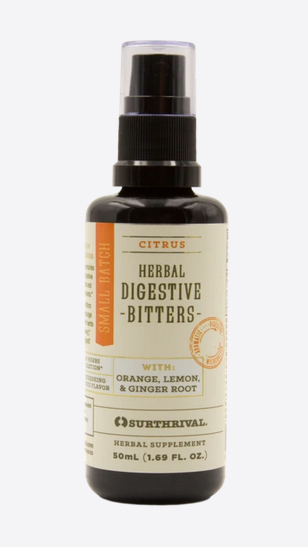
Another viable option you can implement is the use of digestive enzymes/bitters. These broadly include all herbs or supplements with a bitter taste. Bitters are commonly used in herbal medicine before, during, or after a regular meal to gently promote healthy digestive juices and optimal nutrient absorption by boosting your body’s hydrochloric acid (stomach acid) to effectively break down food, reducing digestive issues like nausea, indigestion, heartburn, and more (what’s Pepto Bismol?!). They also relieve gut inflammation and protect the stomach and liver.
By incorporating bitters into your regime, you’re telling your gut and brain to gradually produce more digestive enzymes. Watch out though, as some manufacturers create formulations with herbal extracts that mask the bitter taste, making it less effective. Bitters are needed to activate bitter taste receptors (TAS2Rs) in the body (especially those on the tongue), which means you will not get the full effects by bypassing or masking their somewhat unpleasant flavour.
Try going local, wildcrafted/organic and handmade instead, and get to know your local herbalists and their unique, truly bitter formulations without any added pesticides, flavours, colours, preservatives, fillers, or excipients.
To unfold all of this potential, tap into this state that is dominated by the hormone acetylcholine (choline is the chemical and metabolic precursor to this, top sources include grass fed beef liver and pasture raised eggs), which drops the heart rate. Try to put down your phone, turn off the TV, laptop, desktop, tablet, smart watch, and video game console. My advice: after you cook in a relaxed state while infusing delicious, organic, seasonal, local ingredients in your dish with self-love, be fully present, have fun, thoroughly chew your food mindfully, and enjoy every molecule of the food that you’re feeding your vessel with gratitude.
Thank your food! Even if the food itself isn’t the best quality, the way you prepare it and the mood you’re in when you cook infuses positive energy into it. I’m sure you’ve felt this from having Grandma’s chicken soup or something similar. Cooking doesn’t have to be a chore, cook with love. Try eating outside under the sun with the fresh air and taking a few deep breaths before enjoying the food! Food is unbelievably powerful, and meal time can be a sacred ritual. Don’t be afraid to make the mundane magical.
Stay hydrated and dial in your sleep
Can’t make it out of bed? Mid-day slump? Difficulty falling asleep? It’s almost cliché at this point, but it’s so real: cultivating the art of proper sleep will create the optimal conditions for your body to go into cellular repair, recovering from illness and exercise, and I cannot stress the immense power of dedicating your energy towards consistent sleep/wake times, ideally falling asleep before 10 pm and waking around sunrise to align with the planet’s cycles (I admit this is an ongoing challenge for me!). Natural light is a huge environmental determinant of your body’s physiological processes, signalling the release of certain hormones, and to stay in sync with the day/night cycles of the earth’s rhythms. Avoid artificial light after sundown as much as possible as it tricks your body into thinking it’s daytime, interferes with natural melatonin production and your circadian rhythm, and your ability to get a deep sleep!
Use a pair of blue light blockers if you’ve got screens to look at after sunset (and if you’ve got prescription glasses like me, use a larger blue light blocking pair or a clip-on pair over them). Yes, it can look goofy, but this will help your body know that it’s almost bedtime and to realign your circadian rhythm. For lighting, you can also use a salt rock lamp, detoxifying beeswax candles, install red light therapy lighting, or use amber bulbs to replace the use of conventional, artificial indoor lighting. Oh, and turn off that tv/game console/phone screen/computer, and try to keep electronics out of your bedroom, or unplug them all before sleeping in total, uninterrupted darkness. You’ll know your practice has been working when you wake up feeling refreshed after a full night of uninterrupted, deep sleep.
Cultivate your circadian rhythm in accordance with the earth’s cycles. Expose your face and eyes to direct daylight as much as possible, especially in the early morning sun from sunrise until 10 am. Take lots of walks. Early morning and late afternoon/evening are peak times for this, and I recommend exposure for at least 15-20 minutes (or to tolerance) without burning and without sunscreen as a general guideline. At solar noon (around noon to 1 pm in the spring/summer where I live), I often like to expose as much bare skin as possible to the sun for about 15 minutes without sunscreen. It might sound silly, but I often take off my prescription glasses as I enjoy my meals outdoors, sometimes wearing a swimsuit under the sun so my eyes and skin can really absorb it all, and in the summer I water the garden early in the morning without my glasses on!
Click here for my in depth article, 17 Tips for the Best Sleep of Your Life.
Hydrate your living cells with clean and living, wild water: spring water or properly filtered (reverse osmosis) water that is restructured, rather than unfiltered tap, Brita filtered, or municipal water. Clean water is sacred and alive. Use it in all of your cooking and everything you consume. You will feel a difference, I promise. Click here for Dr. Gerald Pollack’s book, The Fourth Phase of Water, that goes in depth on this vital element. You may have also heard of copper tensor rings and structured water vortexes, and these might not be totally necessary, but if you can access any of them and if you feel like they could optimize your water, go for it. Your skin has a microbiome that is affected by the chlorine and other toxins in shower water (chlorine literally kills the microbiome), so invest in a cheap but effective shower water filter. Best decision I’ve made this year: my skin is now smoother and naturally hydrated, and my small patch of eczema has died down.
Get outside, but seriously
Sunshine on bare skin is the ultimate way to get your vitamin D, much like free roaming animals do. Sunshine is medicine in itself, it is the source of all things, it shapes life. When your skin is exposed to sunlight, it makes vitamin D from cholesterol. The sun’s ultraviolet B (UVB) rays hit cholesterol in the skin cells, providing the energy for vitamin D synthesis to occur. Your mitochondria and gut microbiome love this. With more organic/biodynamic/pasture raised, grass fed foods and healthy fats integrated into your life (no sugars or industrial seed oils), you’ll probably find increased skin resilience like I have, without any need for toxic sunscreens, and you might even begin to tan rather than burn.
Breathing in fresh, flowing air, shaking off stagnant thought and emotional patterns, and immersing yourself in nature is honestly medicine in itself. From gardening to rewilding yourself with forest bathing and forest hikes, foraging, river swims, sunbathing and barefoot beach runs: getting back to wildness and breathing your biome has never been so crucial in this age. Try to get daily sun exposure for at least 20 minutes daily or whatever intuitively feels right for you, not only for vitamin D synthesis, but also to program your circadian rhythm. Use a non-nano zinc based non-toxic sunscreen made with ingredients you would eat, if you must, and actually get outside, as the beneficial UVB rays and full spectrum light cannot reach through windows.
Connection with nature deeply impacts all aspects of health, and in fact, radiant health is our default state. We are not meant to be cooped up in sanitized drywall boxes with toxic, stagnant air, hunched over and staring at blue light from screens all day, blasted with EMF radiation and artificial light that tricks our bodies that it’s constantly the same time of day. Many of us thrive better when running around, breathing fresh air, and getting exposure to natural sunlight from sunrise to sunset. It doesn’t mean we need to flee from our urban environments to live barefoot in the forest (although that would be nice IMO), but it can tell us that taking more breaks to enjoy and get a little closer to nature (ourselves) won’t hurt.
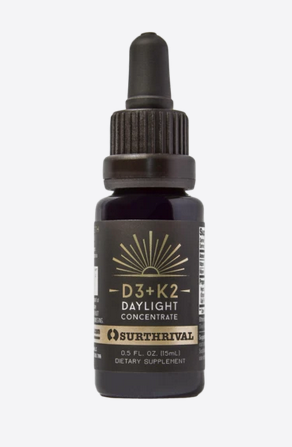
You are alive. Not a robot. Connect with the Mother, with each other. Go barefoot and bare skinned, as much as possible. Walk in the dirt, swim in the lake or ocean, hug a tree, forage wild herbs and nuts, go camping, start a bonfire, tend to a garden, take a walk. Exposing your microbiome to diverse environments introduces different probiotics, releases positive ions and picks up beneficial negative ions, and allows you to feel yourself as part of the bigger living biome and your vast interconnectedness with the cosmos, the trees, animals, humans, plants, dirt and flowers. Veganism ironically disconnects you from all of this as it places a hierarchy on who “matters” (we are one, everything is interconnected).
All of the above elements (and more) come into play to form the bigger picture that is your ever-changing state of vibrant health as you integrate more transformations into your life, whether you follow a vegan ideology or not.
Trust the constant healing process
Lifestyle shifts are pathways to growth and transformation, and getting to really know and honour yourself is a true gift in this lifetime. Be prepared to let go once something no longer works out for you as you are always in a stage of continual becoming, shedding, and unfolding. You have the power to seek verified sources of guidance, but you also have the power to trust yourself when it comes to your own health path, without having to blindly rely solely on externally imposed systems. You’re the one who makes the final call: if something doesn’t feel right with your soul, don’t do it.
The body is incredibly resilient and will always find ways to compensate, even in varying states of malnutrition or imbalance. So often there is an event, or a “straw that breaks the camel’s back” that reveals numerous issues, whether it be symptoms, surgeries, injuries, illness, trauma, etc. It is never just one thing or one cause, and these can be blessings in disguise that serve to awaken us to our daily patterns, and find healing. The subjectivity of “health” in mainstream society is at the root of so much suffering today. Why wait for a major event when you can take action, no matter how small, to resolve that eventual suffering now? Even if you’ve experienced an event, you can come back many times more resilient. It is never too late to thrive.
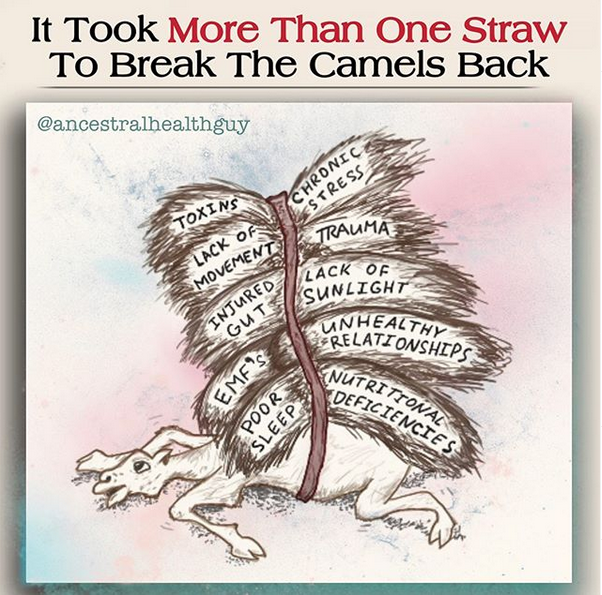
Making the best choices for your well-being doesn’t have to be overwhelming. Your body wants to thrive and reach a homeostasis, so practice patience and loving kindness towards yourself. Take your time, peel off the layers. You are already whole. Tune in, listen, trust your instincts and inherent genius, relax, nourish, breathe, flow, and simply be, come home to yourself. You are worthy of getting where you want to be and life will always give you what you need, exactly when you need it.
TL;DR: whole food, plant based “diets” can be useful over short periods of time to ease digestion (similar to a fast), but over the long term, won’t optimally help you withstand today’s modern environment heavy on the isolated artificial blue light from screens and nnEMFs. Consider looking at what your ancestors primarily ate, your current environment, and go from there!
Hopefully some of that resonated and possibly helped you along your path, as an invitation for you to really get to listen to your own body. When we heal ourselves, we heal all around us. Have you experienced something similar or do you have any insights you’d like to share? Let me know in the comments!
“Tend to the part of the garden you can touch.”
Discover more:
Why I’m Not A Vegan by Daniel Vitalis — Rewild Podcast
Signs of impaired cognitive function in adolescents with marginal cobalamin status
The role of nutrition in children’s neurocognitive development, from pregnancy through childhood
Meat Supplementation Improves Growth, Cognitive, and Behavioral Outcomes
Vitamin B12 deficiency and its relation with neurological disorders
Dietary animal protein intake: association with muscle mass index in older women
From the Bench to the Bedside: Branched Amino Acid and Micronutrient Strategies to Improve Mitochondrial Dysfunction Leading to Sarcopenia (all nutrients from the animal-based whole food matrix provides cofactors for their proper utilization in the body)

